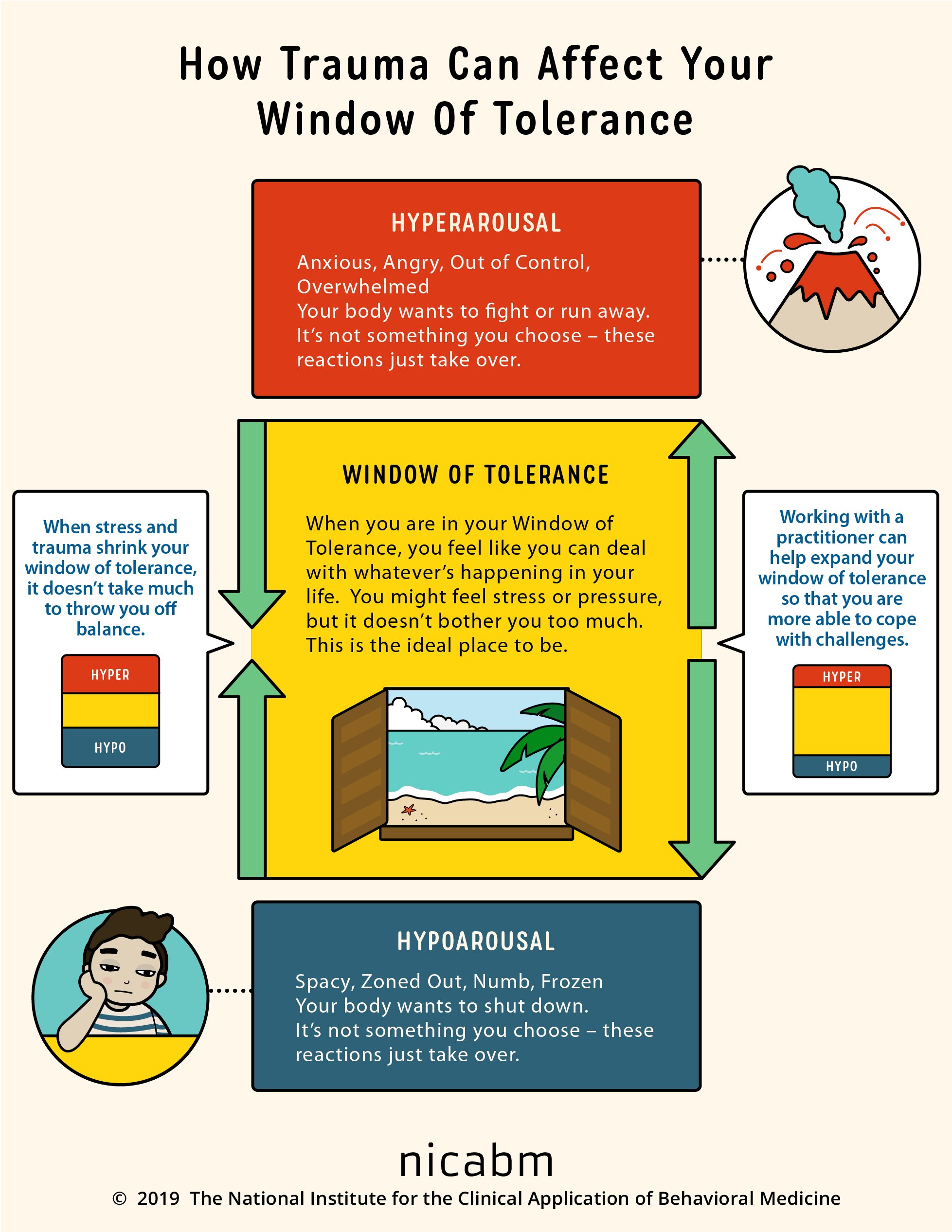Nervous System Basics: Part II
Article at a glance
In the article Nervous System Basics: Part I, we discussed the basics of polyvagal theory and the three main nervous system responses. We also briefly touched on what it means to have a resilient nervous system. In this article, we will discuss:
The Window of Capacity and resiliency
How the state of the body impacts the state of the mind
And how SomaWell can help you to create a supported Nervous System and expand your Window of Capacity
The Window of Capacity (Tolerance)
Below is a great visual of the Window of Capacity from the National Institute for the Clinical Application of Behavioral Medicine.
Polyvagal Theory refers to this as the ‘window of tolerance’. I like to call it the Window of Capacity, as I learned from one of my teachers and mentors Jane Clapp. Life is not just about ‘tolerating’ discomfort and stress. Rather, it is our birth right to develop our capacity to thrive in stress and ease, to experience life, and to feel alive and empowered.
“We speak of ‘capacity’ because it is in this zone that we are able to experience our power, dignity, and ability to fully thrive.”
In the window of capacity
When we are in our window of capacity, we are capable of feeling activation and responding to stress & conflict. We may also feel more capable of social engagement and connection. We may feel more grounded to make a conscious choice and respond with awareness, instead of reacting in autopilot.
In our window, we can also experience the ‘energy conserving mode’ in the body and move towards parasympathetic rest & digest, without shutting down or moving into freeze.
As we work to expand our window over time, we create more resilience in the nervous system. It is also important to note that being in our window doesn’t always mean we are happy and calm. Rather, we are able to adapt to stressors without slipping into hyper or hypo arousal.
WHEN STRESS EXCEEDS OUR capacity
When stress exceeds our internal & external resources, we may leave our window, and the nervous system may react with the patterned response that is most familiar with - we move into hyper or hypo arousal.
Hyper Arousal: moving towards Sympathetic Nervous System State (chaos in the nervous system).
Flooded with emotional reactivity and sensation
Hypervigilance
Anxiety, panic, fear
Hypo Arousal: moving towards Parasympathetic Dorsal Vagal shut down & freeze state (rigidity in the nervous system).
Feeling of numbness
Depression, lethargy
Decreased cognitive function
The Nervous System Impacts the Narrative of the mind
Polyvagal Theory helps us to understand how the Autonomic Nervous System reacts and responds to experiences, by ebbing and flowing in and out of social engagement, mobilization, and collapse.
The body is the filter in which we perceive the world around us. Through the process of neuroception (detecting danger & safety), we first feel something in the body, then we experience emotions, create narratives, and perform behaviors; and all of this happens in a split second beneath our awareness. The state of the body also impacts what is happening in the mind. When we are outside our window of capacity in either hyper or hypo arousal, we might experience complicated mind narratives.
Deb Dana describes ‘stories about self, the world, and relationships are developed based on our internal body state’. In other words, state creates story.
physiological state creates story
- Ventral Vagal “Social Nervous System”: In this state we can access connection and collaboration. We can communicate with others, and have compassion for others and ourselves.
- Sympathetic “Fight or Flight”: In this state we may experience feelings of scarcity, competition, and fear-based judgment.
- Dorsal Vagal “Freeze & Immobility”: In this state we may experience feelings of self criticism, hopelessness, ‘stuckness’, and comparing ourselves to others.
Of course, these stories are different for all of us and it’s not as linear and simple as this, but the body can influence which ‘parts’ of us speak up and what narrative flows throughout the mind all day. As we consider trying to shift cognitive thoughts patterns and behaviors to improve mental health & wellbeing, the body and nervous system can be a good place to start.
SomaWell Sessions + Nervous System Support
SomaWell Sessions are designed to help you create support in the nervous system, and we consider the principles of PVT in coaching & movement.
SESSIONS CAN HELP YOU TO:
Become embodied and become aware of your unique physiology
Expand your window of capacity, and build your inner and external resources to handle stress and to feel activation without getting overwhelmed
Develop capacity for rest & stillness, increasing parasympathetic tone
Create nervous system support - ‘Nervous System Regulation’ is the term used in Polyvagal Theory, although I like to call it support.
and more!
QUESTIONS TO REFLECT ON:
Maybe you are wondering how nervous system support would benefit you, here are some questions to reflect on:
Are you able to recognize the physiological state you are in?
Can you hear the narrative, the emotional tone, and recognize the autopilot behaviors associated with each physiological state?
What resources do you have to bring support to the body in each state?
Do you feel one state dominates your life over other states?
If you feel ready to explore this type of somatic work, SomaWell is here to support you. Please schedule your next session here.

